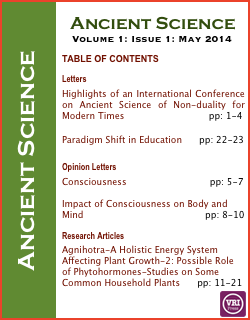
Agnihotra-A Holistic Energy System Affecting Plant Growth-2: Possible Role of Phytohormones-Studies on Some Common Household Plants
Abstract
The present study done as a sequel to the previous one that assessed the effect of Agnihotra vapour on some common household plants, has again confirmed the results of previous research. Some new plants were also included in the experiments for reaffirmation of the assessment. The results have shown conformity to the previous study.
In the new study, only the polished grain vapour was used. It was observed that most plants responded by tremendous leaf proliferation where the new branches were produced in axils of each and every old leaf. Lateral bud initiation seems to be main effect of the vapour.
 A rose plant kept in the atmosphere of Agnihotra showed that a new branch had grown from the side at the bottom of the plant, and this new branch produced became equal in height to the older branches in 3 days time ( cell elongation) and went on to produce buds.
 Some plants responded by showing increased senescence giving way to the reproductive structures. The experiment designed with bottled money plants kept in the Agnihotra atmosphere responded by producing new leaves and roots while control plant s kept in the same light and air conditions had shown no new growth. The paper offers a scientific background for Agnihotra’s effect on plants.
Â
Keywords
References
Limaye V: Agnihotra: A Holistic Energy System Affecting Plant Growth (Studies some common Household plants). Asian Journal of Multidisciplinary Research 2013, 1(1).
http://www.fivefoldpathmission.org/content/what-agnihotra (Assessed on8th, Feb, 2014).
Paranjpe VV: Homa Therapy Our Last Chance: Five Fold Path Inc., Parama Dham (House of Almighty Father); Madison, 1989.
https://www.biodynamics.com/content/heal-atmosphere-neutralize-radiation.
Potdar MM: Agnihotra: For Equilibrium of Nature and Enhancement of Human Life. Akkalkot: Institute for Studies in Vedic Sciences; 1990.
Selvamurthy W: Physiological effects of Mantra on mind and body. In Yoga conference November, 1989; Delhi: 1989.
Golechha G, Deshpande M, Sethi I, Singh R: Agnihotra-A Useful Adjunct In Recovery Of A Resistant Demotivated Smack Addict. Indian journal of psychiatry 1987, 29:247.
Ramjivale S: Agriculture farming method- an adjunct to ecological farming practices edn 2nd. Akkalkot: Institute for Studies in Vedic Sciences; 1999.
Kratz S, Schnug E: Homa Farming-a vedic fire for agriculture: Influence of Agnihotra ash on water solubility of soil P. Landbauforschung Volkenrode 2007, 57:207-211.
Mondkar A: Agnihotra effect on aerial microflora. US Satsang 1982, 9:20.
Pachori RR: Effect of Agnihotra fumes on Aeromicroflora, The Bioscan2013, 8(1):127-129.
http://www.vedicsociety.org/pdf/report_somayagya_maheswar.pdf
Devi HJ, Swamy N, Nagendra H: Effect of Agnihotra on the germination of rice seeds. Indian Journal of Traditional Knowledge 2004, 3:231-239.
Indira V, Dhasarathan P, Anandadevi M: Impact of agnihotra in mushroom cultivation technology, J. Biosci. Res 2010, 1(4):245-250.
Taiz L, Zeiger E: Plant Physiology, Ed 2nd. Edited by: Sinauer Associates, Inc., Sunderland, Massachusetts; 1998.
Raven P, Evert R, Eichhorn S: Biology of Plants edn 6th. New York: W. H. Freeman and Company; 1999.
DOI: http://dx.doi.org/10.14259%2Fas.v1i1.101
Refbacks
- There are currently no refbacks.










